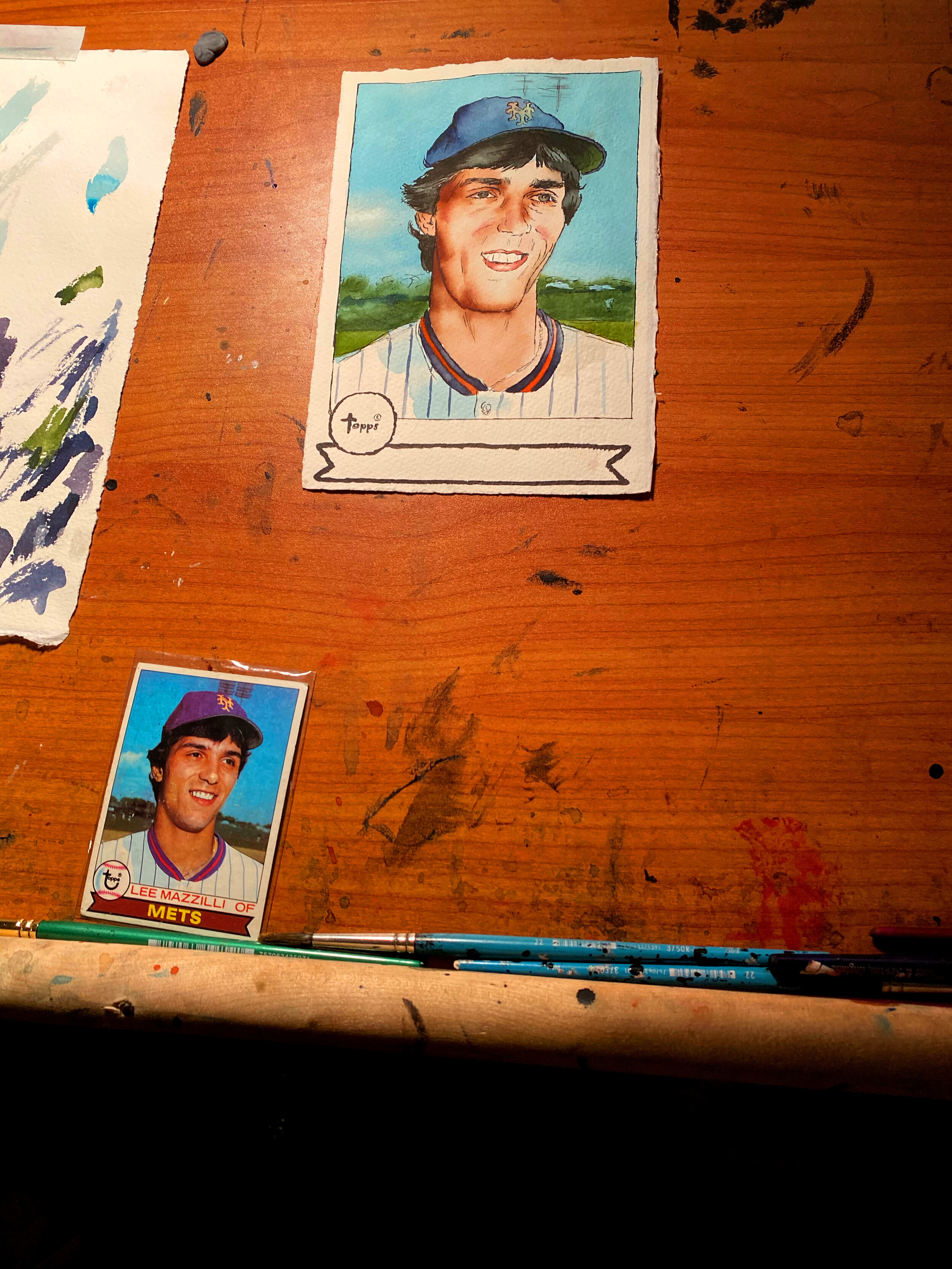About
about Spotlight 70
“Spotlight70” is a seventy-card set of Friedman’s ink and watercolor drawings of baseball cards culled from the Topps archive, which features a diverse range of “fan favorites,” from Gene Tenace and Vida Blue to Lee Mazzilli and Lloyd McClendon.
Spotlight70 Card #45, Lee Mazzilli, in progress.
In collaboration with Topps, “Spotlight70” continues the iconic brand’s ongoing, groundbreaking series of collaborations with artists from around the globe in celebration of the company’s seventieth anniversary.
“Gerald Young,” from “Loneliness of the Common Player” (The New Yorker)
Friedman documented his lifelong affinity for drawing baseball cards in “The Loneliness of the Common Player,” an illustrated essay that appeared on The New Yorker web site in 2015.
“Rick Peters,” from “Loneliness of the Common Player” (The New Yorker)
“The cards that I’ve held onto continue to stimulate my emotions in different ways,” he wrote. “Childhood memories live in their ink-black shadows, distant radio towers, blurry treetops, and cerulean skies…I look at these cards the way Cézanne might have looked at Mont Sainte-Victoire from the Bibemus Quarry.”
Illustration of a Zoom call with Mike Schmidt for “Storybook Season: An Interview with Mike Schmidt” (The New Yorker)
In 2020, Friedman illustrated his online, in-depth interview with his favorite baseball player, Mike Schmidt, the Hall-of-Famer and former Philadelphia Phillies third baseman, also for The New Yorker.
Friedman’s caricatures have twice graced the cover of The New York Times Magazine.
Though he illustrates celebrities for magazines, publishes his cartoons in The New Yorker, and tours the country in support of his music, Friedman, a graduate of The Rhode Island School of Design (’97) with a degree in painting, has always considered himself a painter above all.
“The Pilot LIght,” 1997, oil on canvas, 19 1/4” x 26 1/2”.
But his path as a traditional fine artist was diverted after art school when his day job as a messenger at The New Yorker prevented him from continuing his daily practice as an oil painter working in the time-consuming Venetian method.
Friedman’s debut album, 2006’s “Taken Man,” on the shelves at Cactus Music Record Ranch in Austin, Texas.
Soon after, he shifted his focus to music, but not before he found success as a cartoonist.
Friedman’s first published cartoon in The New Yorker, 2000.
“My initial interest in cartooning was little more than an exercise in learning how to write country music lyrics,” he explains. “Both artforms encourage an economy of language and form, and the ability to say the most with the fewest strokes.”
Larry Hat quoted in the Cindy Adams gossip column in The New York Post, 2000.
Friedman’s first cartoons were published under the pseudonym Larry Hat out of fear that people would take his art less seriously if they knew that he was funny.
Friedman has recorded three albums of his original songs, 2006’s “Taken Man” (above), 2008’s “Weary Things,” and 2011’s “Laserbeams and Dreams.”
Through his cartooning and music, Friedman learned to celebrate limitation and embrace vulnerability with his art. His first album of original songs, 2006’s “Taken Man,” which features Old Crow Medicine Show’s Ketch Secor on fiddle, was recorded less than a year after he taught himself to play guitar. Until the recording session, he had never sung a serious note into a microphone.
Friedman’s “Taken Man” appears at #30 in a New York Post “207 Best Songs” list.
A few months later, the album’s title track appeared on a New York Post “Best Songs” list beside Bruce Springsteen, Amy Winehouse, and Neil Young. In a 2011 Vanity Fair interview, the Avett Brothers’ Scott Avett included a different track from Friedman’s debut record on a short list of his own favorite songs.
“Jose DeLeon,” ink and watercolor, from “Loneliness of the Common Player.”
After a 2012 diagnosis of carpal tunnel syndrome robbed the academically trained, self-described “former perfectionist” of the steady line upon which his renown as an illustrator was built, Friedman found strength in the hard-won lessons of economy and restraint learned throughout his expansive and singular career as an artist, which has spanned two decades, by drawing baseball cards.
Spotlight70 card #9, Bucky Dent, of the New York Yankees, based on a 1981 Topps design,
“Spotlight70” is not only an ode to Topps’ profound legacy of achievement in the fields of graphic design and portrait photography, but a series of improvisational performances by a visionary artist in two of the most difficult mediums in existence.
Spotlight70 card #48, Louis Tiant, of the Boston Red Sox, based on a 1975 Topps design.
“With ink and watercolor,” explains Friedman, “mistakes are impossible to correct.”
An example of the card back design for the Spotlight70 set, which is printed on vintage stock.
The autobiographical “Talkin’ Andy” component on the back of each card, which pays homage to the quirky quizzes and list of highlights traditionally about the players, is another aspect of “Spotlight70” that makes the set unique. Each offered fact delivers tidbits of information about Andy’s art, process, life, and career.
Ten lucky collectors will find in a pack an original drawing signed and dated by the artist of a stick of gum.
The collection, which contains seventy cards, in addition to parallels and variations, including ten randomly inserted signed original drawings of a stick of gum, is printed on vintage stock and was available in foil packs of ten for the month of August, 2021, at Topps.com.
2021 Topps x Spotlight 70 - Card #12 - Dale Murphy - Artist Proof # to 25
Each week of the Spotlight70 sales window, Topps also presented three new artist proof cards in numbered editions of twenty-five, all of which sold out.


















